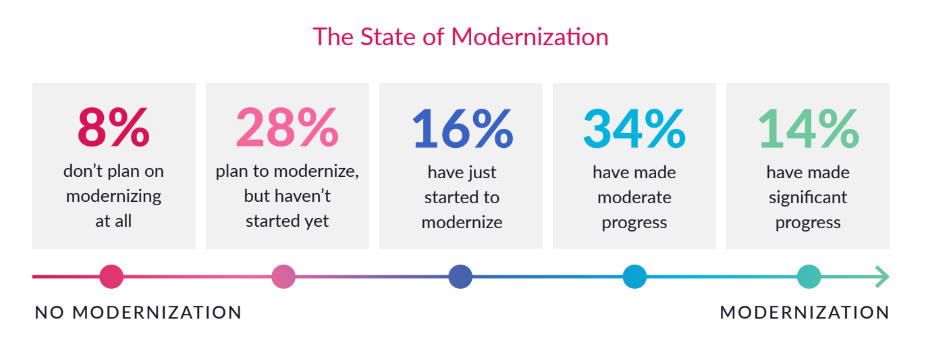Survey: 92% of Enterprises Working on, Planning App Modernization
A survey finds 92% of enterprises are working on or planning an app modernization project, even though most admit an earlier failure. IDN talks with Bob Quillin of Vfunction, the firm that comissioned the study.
by Vance McCarthy
Tags: AI, app modernization, cloud, Java, refactoring, vFunction,

chief ecosystem officer

"Teams with the biggest monoliths have all been working on modernizing their app for several years with limited progress and high levels of frustration. "
Virtual Summit
 Enterprise-Grade Integration Across Cloud and On-Premise
Enterprise-Grade Integration Across Cloud and On-PremiseAn astonishing 92% of enterprises say they are actively working on at least one app modernization project, according to a recent survey.
Perhaps even more noteworthy, the survey said four-in-five respondents (79%) also admitted they had experienced an app modernization failure.
Wakefield Research conducted the research. The study entitled "Executives and App Modernization: What Architects Want You to Know About Why App Modernization Projects Fail" was commissioned by vFunction, an AI-driven modernization platform for architects and developers.
"Given the expense and length of these projects, it's critical to understand why they are successful and why they fail; there is a lot on the line," said Moti Rafalin, CEO vFunction, in a statement. A "lift and shift" [approach] is no longer considered a successful modernization outcome," he added.
The survey revealed that many architects and software developers face many challenges regarding app modernization, Bob Quillin, vFunction's chief ecosystem officer, told IDN.
"Debilitating costs from accumulated technical debt have stymied innovation efforts," Quillin said. "The true cost of technical debt must be understood, and a business case must be built to garner C-Suite buy-in," he added.
In other words, without investments to modernize, today's legacy apps have become too complex, unwieldy, or fragile to meet today's business needs.
Identifying and Avoiding Perils of Traditional App Modernization
"Modernization projects have proven complex, expensive and risky," the survey said.
Among its specific findings were:
Complex and Time-Consuming – More than half (58%) of software and architecture leaders say the typical app modernization effort, on average, takes 16 months per project. More than a quarter (27%) say such projects take two years -- or more.
Expensive – Almost three-quarters of respondents (74%) say a typical application modernization effort can cost on average $1.5 million.
Risky – App modernization project failures can be common. Some four in five (80%) told the survey they have had at least one app modernization effort fail.
"Executives and architects agreed that "Risk" is the top reason for pushback on application modernization projects in an organization," Quillin told IDN and shared more perspectives.
Application modernization today has been fraught with frustration. While the goals for executives and developers are stated differently, they all revolve around a desire to move faster (speed innovation, improve engineering velocity) and better help the business (keeping up with business requirements, finding and ramping developers to maintain the apps).
When asked "what were the most difficult steps of application modernization," respondents agreed that "Securing Budget and Resources" was the most difficult, along with (a) Knowing What to Modernize and (b) Building a Business Case.
Quillin also shared vFunction customer experiences, which attests to app modernization projects' challenges.
The teams with the biggest monoliths (10's of millions of lines of code, thousands of classes) have all been working on modernizing their app for several years with limited progress and high levels of frustration.
A recent customer had been at their project for over two years. While expectations at the beginning were high (similar to those mentioned above), the tools they were using were very rudimentary profilers and app performance monitors - not "intelligent tools" purpose-built for refactoring.
They had opted to lift-and-shift to the cloud first but immediately met challenges with performance and scaling. It became necessary to keep their app always-on and over-provisioned even when not being accessed. Their lack of scalability, deployment speed, and low product agility forced them to reject feature requests, which led to bigger customer issues, lost renewals and broken contracts.

Technical Causes of App Modernization Failures
In the survey, architects blame "a lack of intelligent tools" and "inadequate skills or training" as the top reasons for app modernization failure.
Quillin shared with IDN the technical challenges customers face when doing an app modernization project.
One of the top drivers for app modernization cited in the survey was to "reduce the ramp time for new developers," echoed by the top challenge in maintaining existing monolithic apps as "finding and ramping developers who can maintain them." It's just hard to find, motivate, and retain developers who must work on legacy code and wade through antiquated, complex architectures.
Bridging the skills gap requires a commitment to training and an acknowledgment of this fear of change.
By choosing refactoring as your modernization approach, this can build that bridge from the monolith and existing business logic source code to a newer microservice architecture that leverages your existing intellectual property and people power to move the product, the team, and hence the business itself forward as one.
This survey indicates that active modernization practitioners are beginning to decipher the difference between migration methodologies (such as replatforming and rehosting) and more "effective" (per the survey response) modernization strategies such as refactoring and re-architecting.
How vFunction's Smart Tools, AI Speed and Simplify App Modernization
"Most importantly, architects need intelligent tools for the job" of successful app modernization, Rafalin added.
vFunction is designed to deliver a scalable, repeatable factory model to accelerate modernizing apps for a cloud-native architecture. Quillin shared details on how vFunction's technologies offer smart tooling and speed developer onramping.
The core of what vFunction does is to automate and accelerate the refactoring of monolithic applications with AI-based intelligence purpose-built to rapidly identify dependencies, domains, and service boundaries and enable the extraction of microservices from a complex monolith (often consisting of millions of lines of code and thousands of tangled, dense classes). From a people perspective.
vFunction Modernization Hub reduces the years of built-up frustration by providing intelligent tooling to accelerate the refactoring process, reducing the oft-cited risks by explicitly pinpointing what to modernize, why, and how.
vFunction Assessment Hub is targeted at solving the up-front issue of building a business case that accurately sets expectations by measuring technical debt at an architectural level. This is the launching point for an accelerated modernization project that executives and architects can mutually agree upon based on a data-driven foundation.
vFunction quantifies technical debt by combining application complexity measurements based on levels of entanglement between classes and the resulting risk of change based on the length of dependency chains. The resulting technical debt scores across your application estate allow for prioritization, justification of modernization methods, and a before and after benchmark.
Corporate "Culture" Also Impacts App Modernization Success
For all the discussion of technology and tools, the survey also found such app modernization failures are not just a technology or skills issue.
Sometimes the organization's DNA can spell the difference between success and failure for app modernization.
On this point, the study found: "Internal organizational struggles and the misalignment between business and technology teams are putting app modernization efforts in peril before they even start." The study's findings documented 'culture; challenges with these stats:
- Almost every respondent (an astonishing 97%) predicted someone in their organization would "push back" on a proposed project.
- 50% of executives and architects agree that securing the budget and resources is the "most challenging step" in a modernization project.
- 43% of those who have seen app modernization failures blame expectations not being set correctly
- Another 37% blame failure on required organizational structure changes.
In other words, the study concluded that "failure to accurately set expectations" is also a cause for failures.
Architects "need the C-suite to align and train the team for success, and help build the business case required to secure the budget and resources needed," vFunction CEO Rafalin noted.
Quillin also detailed to IDN how crucial corporate culture is to app modernization success.
The cultural impact of application modernization has become even more critical as digital transformations accelerate and remote work and team topologies shift to smaller, more agile (less monolithic) teams.
It's critical to address the cultural impact upfront as top reasons for pushback in the survey included both "stakeholders fear of large change" and "fear of losing their role." Supporting this is agreement that a lack of "required organization structure changes" is another top reason for app modernization project failures.
The more that teams can apply a data-driven assessment up front, the better chance they have of setting clear and shared expectations by knowing what (and how and why) to modernize spelled out in a compelling and grounded business case.
Setting expectations upfront with a strong quantification and analysis of the technical debt that the monolith is carrying is a winning formula.
The survey was conducted among 250 architects, software developers, and architects at companies with 5,000 or more employees that have been in business for at least 15 years, currently maintaining Java applications.
Readers can get a copy of the research report here.
Related:
- The Critical Integration Miss: Continuous Exploration
- Tray.io Low-Code Integration, Automation Updates Drive Enterprise Hyperautomation
- Matillion Adds No-Code, Automation To Speed Delivery of CDC and Batch Data Pipelines
- Tray.io 'Embedded iPaaS' Empowers SaaS, ISVs via Low-Code, Automated Integrations
- API Management vs. Service Mesh: The Choice Doesn’t Have to Be Yours
All rights reserved © 2025 Enterprise Integration News, Inc.


